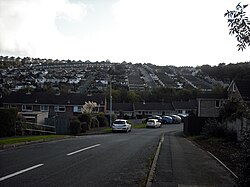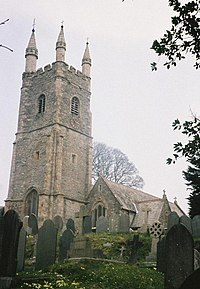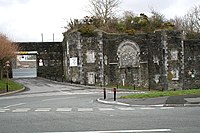Eggbuckland
| Eggbuckland | |
| Devon | |
|---|---|
 Eggbuckland across the A38 road | |
| Location | |
| Grid reference: | SX499575 |
| Location: | 50°24’2"N, 4°6’49"W |
| Data | |
| Population: | 13,351 (2011) |
| Post town: | Plymouth |
| Postcode: | PL6 |
| Dialling code: | 01752 |
| Local Government | |
| Council: | Plymouth |
| Parliamentary constituency: |
Plymouth Moor View |
Eggbuckland is a village of south-western Devon which has become a suburb of the City of Plymouth. Before the Second World War Eggbuckland was a small village a few miles north of Plymouth, but during the reconstruction of the city many new suburbs were built and soon a new estate was built within a mile south-east of Eggbuckland. During the 1970s the areas in between and surrounding the old village were all developed and the whole area is now referred to by the name Eggbuckland. The development of the A38 just south of Eggbuckland in the 1980s led to the area becoming very popular with commuters.

History
The name of the village is ancient. It is recorded Domesday Book of 1086 ad Bocheland which is the Old English bocland meaning 'Leased land' or 'Land held by charter'. The Domesday Book records that this manor was held by the King but was granted to an Englishman named Heche or Ecca: thus the land was known as Heche's or Ecca's Bookland, for which the name 'Eggbuckland' comes. By 1685 the name was recorded as 'Egg Buckland', which remained the normal style for centuries. By 1902, it appeared as one word, 'Eggbuckland', but the older usage is still seen and heard around the city.
This was the site of a Saxon church which was replaced by the present church of St Edward in 1470.
During the Civil War, the village was held by the Royalists against the Parliamentarians and was badly damaged in the fighting.

During the 19th new Palmerston Forts were built here built as part of a northern defence line around Plymouth. The forts' structures survive but are privately owned and used for differing purposes.
In the 1870s, the original village was described thus in John Marius Wilson's Imperial Gazetteer of England and Wales:
- EGG-BUCKLAND, or Buckland-Egg, a parish in Plympton-St. Mary district, Devon; on the Dartmoor railway, adjacent to the Tavistock railway, and near the river Plym, 3 miles NNE of Plymonth. It contains Crabtree hamlet, and part of Knackers-Knowle village; and its post town is Knackers-Knowle, Devon. Acres, with Laira-Green, 3, 304; of which 100 are water. Real property, £8, 933; of which £68 are in quarries, and £36 in railways. Pop., 1, 348. Houses, 272. The property is much subdivided. Widey Court here was the headquarters of Prince Maurice during his siege of Plymouth, and was visited by the king. The living is a vicarage in the diocese of Exeter. Value, £474.* Patron, the Lord Chancellor. The church is ancient: consists of nave, south aisle, and chancel, with a tower; and is in fair condition. Charities, £28.[1]
Outside links
References
- ↑ Egg Buckland Devon, A Vision of Britain through time. Retrieved Nov. 7, 2013.